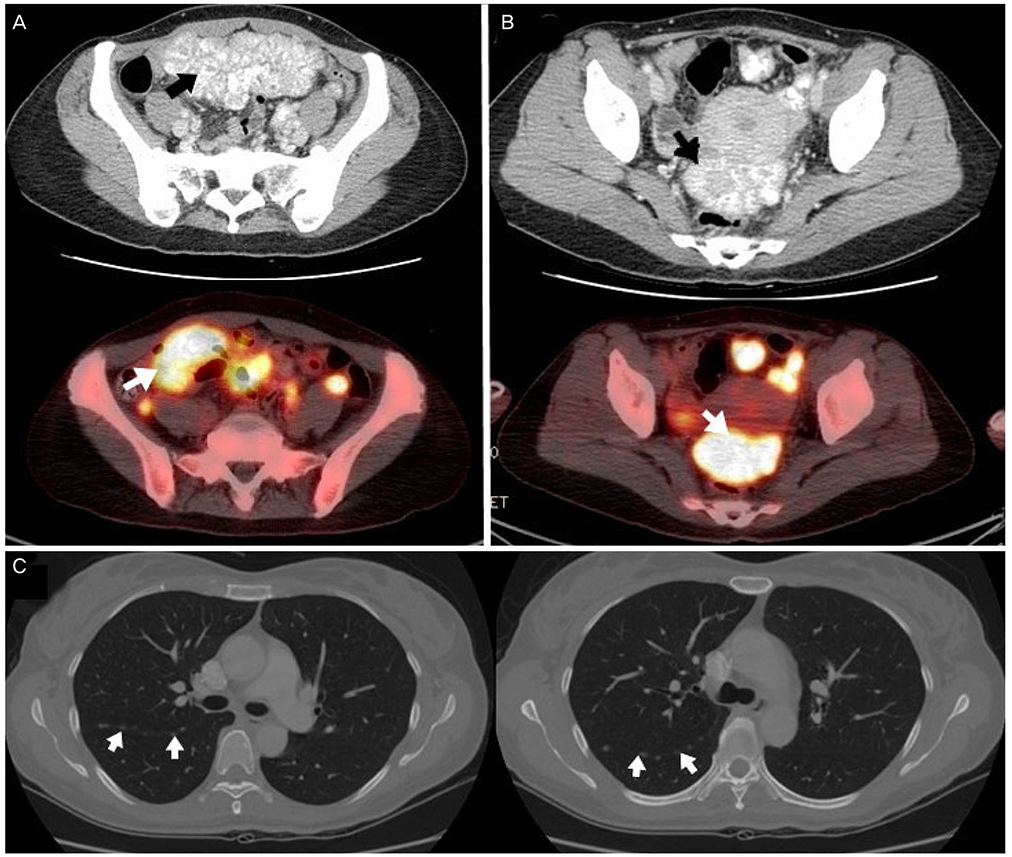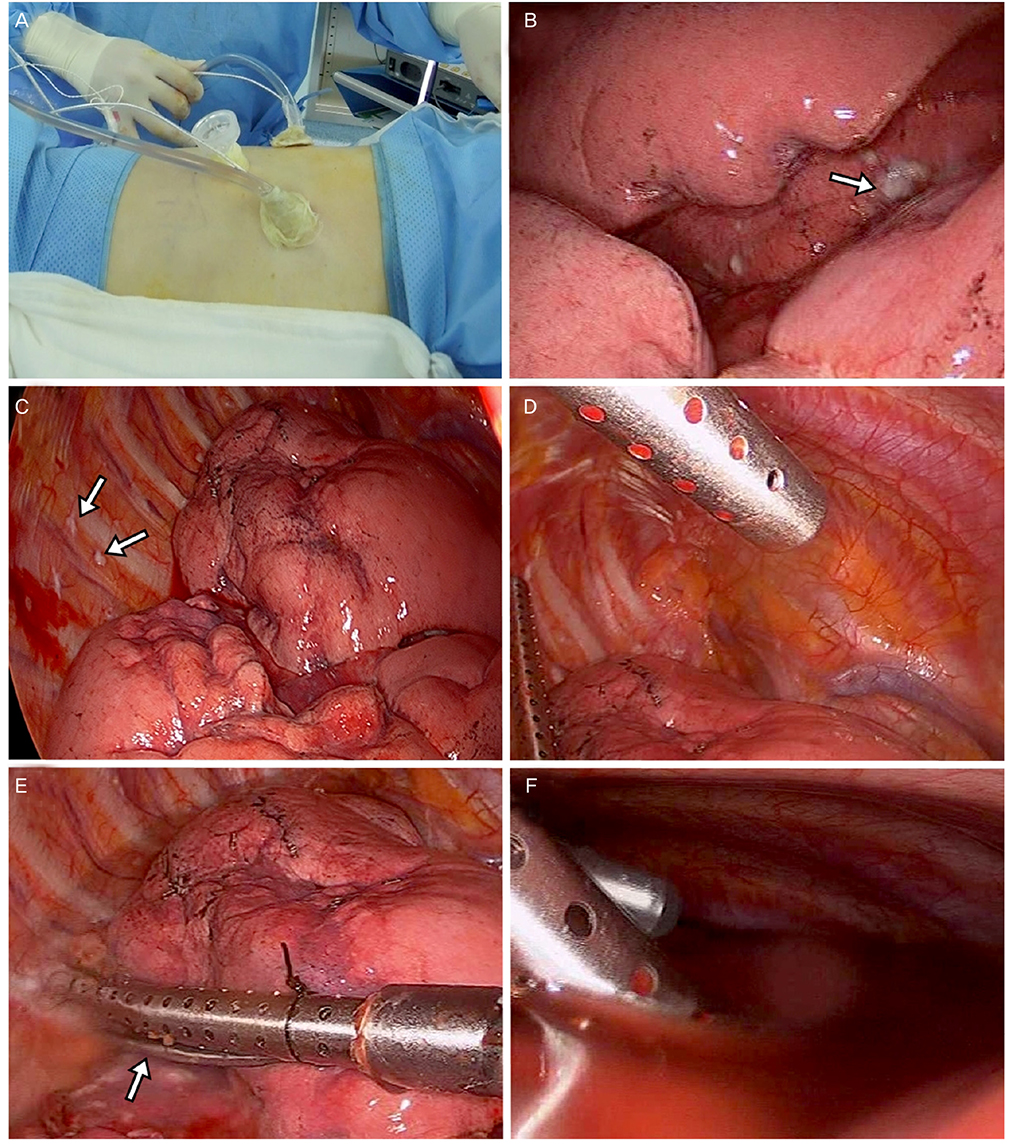Obstet Gynecol Sci.
2017 May;60(3):308-313. 10.5468/ogs.2017.60.3.308.
Hyperthermic intrathoracic chemotherapy with cisplatin for ovarian cancer with pleural metastasis
- Affiliations
-
- 1Department of Obstetrics and Gynecology, Kyungpook National University Medical Center, Daegu, Korea. dghong@knu.ac.kr
- 2Department of Thoracic and Cardiovascular Surgery, Kyungpook National University Medical Center, Daegu, Korea.
- 3Department of Gynecology, National Cancer Center Hospital, Tokyo, Japan.
- KMID: 2378594
- DOI: http://doi.org/10.5468/ogs.2017.60.3.308
Abstract
- Intrathoracic metastasis of ovarian cancer has poor prognosis regardless of treatment modality. Recent development of surgical techniques and the new concept of direct infusion of chemotherapeutic agents with hyperthermia could help with the treatment of disseminated diseases in ovarian cancer. Using video-assisted thoracoscopic surgery and intracavitary chemotherapy with hyperthermia, we tried hyperthermic intrathoracic chemotherapy for a case of stage IV high-grade serous ovarian cancer with pleural metastasis. There was no high-grade complication related to the procedure. The patient is alive without disease at 32 months after initial treatment.
Keyword
MeSH Terms
Figure
Reference
-
1. Cascales-Campos P, Gil J, Feliciangeli E, Parrilla P. HIPEC in ovarian cancer: treatment of a new era or is it the end of the pipeline? Gynecol Oncol. 2015; 139:363–368.2. Petrillo M, Vizzielli G, Fanfani F, Gallotta V, Cosentino F, Chiantera V, et al. Definition of a dynamic laparoscopic model for the prediction of incomplete cytoreduction in advanced epithelial ovarian cancer: proof of a concept. Gynecol Oncol. 2015; 139:5–9.3. Diaz JP, Abu-Rustum NR, Sonoda Y, Downey RJ, Park BJ, Flores RM, et al. Video-assisted thoracic surgery (VATS) evaluation of pleural effusions in patients with newly diagnosed advanced ovarian carcinoma can influence the primary management choice for these patients. Gynecol Oncol. 2010; 116:483–488.4. Lim MC, Lee HS, Jung DC, Choi JY, Seo SS, Park SY. Pathological diagnosis and cytoreduction of cardiophrenic lymph node and pleural metastasis in ovarian cancer patients using video-assisted thoracic surgery. Ann Surg Oncol. 2009; 16:1990–1996.5. Akahira JI, Yoshikawa H, Shimizu Y, Tsunematsu R, Hirakawa T, Kuramoto H, et al. Prognostic factors of stage IV epithelial ovarian cancer: a multicenter retrospective study. Gynecol Oncol. 2001; 81:398–403.6. Perren TJ, Swart AM, Pfisterer J, Ledermann JA, Pujade-Lauraine E, Kristensen G, et al. A phase 3 trial of bevacizumab in ovarian cancer. N Engl J Med. 2011; 365:2484–2496.7. Spiliotis J, Halkia E, Lianos E, Kalantzi N, Grivas A, Efstathiou E, et al. Cytoreductive surgery and HIPEC in recurrent epithelial ovarian cancer: a prospective randomized phase III study. Ann Surg Oncol. 2015; 22:1570–1575.8. Chiva LM, Gonzalez-Martin A. A critical appraisal of hyperthermic intraperitoneal chemotherapy (HIPEC) in the treatment of advanced and recurrent ovarian cancer. Gynecol Oncol. 2015; 136:130–135.9. Lim MC, Kang S, Choi J, Song YJ, Park S, Seo SS, et al. Hyperthermic intraperitoneal chemotherapy after extensive cytoreductive surgery in patients with primary advanced epithelial ovarian cancer: interim analysis of a phase II study. Ann Surg Oncol. 2009; 16:993–1000.10. Deraco M, Virzi S, Iusco DR, Puccio F, Macri A, Famulari C, et al. Secondary cytoreductive surgery and hyperthermic intraperitoneal chemotherapy for recurrent epithelial ovarian cancer: a multi-institutional study. BJOG. 2012; 119:800–809.11. Bakrin N, Cotte E, Golfier F, Gilly FN, Freyer G, Helm W, et al. Cytoreductive surgery and hyperthermic intraperitoneal chemotherapy (HIPEC) for persistent and recurrent advanced ovarian carcinoma: a multicenter, prospective study of 246 patients. Ann Surg Oncol. 2012; 19:4052–4058.12. de Bree E, van Ruth S, Baas P, Rutgers EJ, van Zandwijk N, Witkamp AJ, et al. Cytoreductive surgery and intraoperative hyperthermic intrathoracic chemotherapy in patients with malignant pleural mesothelioma or pleural metastases of thymoma. Chest. 2002; 121:480–487.13. Ried M, Potzger T, Braune N, Neu R, Zausig Y, Schalke B, et al. Cytoreductive surgery and hyperthermic intrathoracic chemotherapy perfusion for malignant pleural tumours: perioperative management and clinical experience. Eur J Cardiothorac Surg. 2013; 43:801–807.14. Yellin A, Simansky DA, Paley M, Refaely Y. Hyperthermic pleural perfusion with cisplatin: early clinical experience. Cancer. 2001; 92:2197–2203.15. Chua TC, Yan TD, Yap ZL, Horton MD, Fermanis GG, Morris DL. Thoracic cytoreductive surgery and intraoperative hyperthermic intrathoracic chemotherapy for pseudomyxoma peritonei. J Surg Oncol. 2009; 99:292–295.
- Full Text Links
- Actions
-
Cited
- CITED
-
- Close
- Share
- Similar articles
-
- Chemotherapy for ovarian cancer
- Intraperitoneal cisplatin chemotherapy for advanced ovarian cancer
- CHIPOR, HORSE, and beyond: unraveling the role of hyperthermic intraperitoneal chemotherapy (HIPEC) in ovarian cancer
- Intrapleural Perfusion Hyperthermic-Chemotherapy for Pleural Seeding of Lung Cancer
- A phase I dose-finding trial of hyperthermic intraperitoneal docetaxel combined with cisplatin in patients with advanced-stage ovarian cancer



